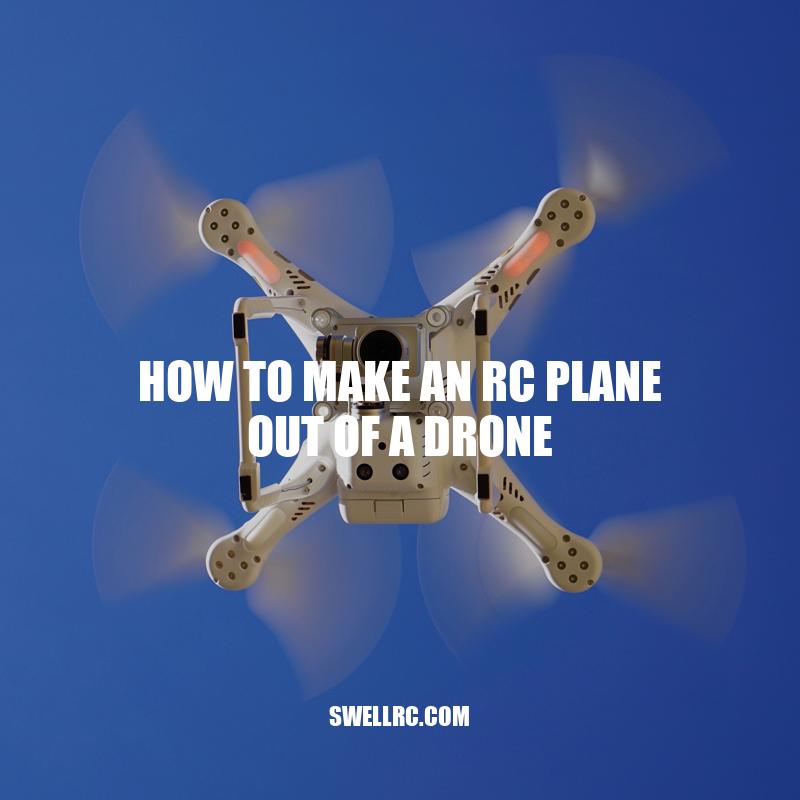DIY Guide: How to Build an RC Plane from a Drone
Remote-controlled (RC) planes are exciting to fly and can be an excellent hobby for anyone who loves aviation or electronics. If you’re interested in making your own, why not create an RC plane out of a drone? Drones have a powerful motor, a versatile control board, and a durable frame that can be repurposed with some modifications to create an RC plane. Plus, the parts can be inexpensive and readily available, making it an ideal project for beginners. With a few steps, you can transform a drone into an RC plane that you can fly in the sky. This article will guide you through the process of building an RC plane out of a drone, including how to choose the right materials, build the frame, install the control board and motor, and add finishing touches. Let’s get started and discover how to make an RC plane out of a drone.
Choosing the Right Drone and Materials
Before starting the project, it’s essential to have the right drone and materials to build an RC plane successfully. Here’s what you need:
- Drone: Pick a durable drone with powerful motors that can carry the weight of an RC plane. Check out popular websites like DJI, Amazon, and HobbyKing for a drone that suits your needs.
- Foam Board: Foam board is the ideal material for building lightweight, sturdy wings and fuselage.
- Control Board: This device controls the various functions of the plane, such as throttle, steering, etc.
- Motor: You’ll need a motor that is powerful enough to lift the plane and provides good speed.
- Servos: These are small motors that control the movement of the flaps and rudder of the plane.
- Glue: Use glue that sticks securely to foam board surfaces.
- Tools: Get a cutting tool like a sharp hobby knife for cutting foam board and a ruler for measurement.
With these materials in hand, you’re ready to build your RC plane out of a drone.
What materials do you need to make an RC plane?
To make your own RC plane, you will need the following materials:
- Balsa wood or foam board for the plane frame
- Electric motor and propeller
- RC receiver and transmitter
- Servo motors for controlling the plane’s movement
- LiPo battery for power
- Epoxy glue for assembly
There are many online resources that can provide more detailed instructions on how to build your own RC plane, including RCGroups.com and Video Aerial Systems. Additionally, companies like HobbyKing and TowerHobbies offer kits and individual components for building RC planes.
Building the Frame
The frame of the RC plane is the foundation that holds everything together. Here are the steps involved in building the frame:
| Steps | Instructions |
|---|---|
| Cut the Foam Board | Use the hobby knife to cut the foam board according to the blueprint that matches the RC plane design. |
| Glue the Pieces Together | Use a hot glue gun to join the pieces together to form the body frame of the RC plane. Cover the frame with a layer of packing tape to prevent it from breaking apart during crashes. |
| Make the Wing and Tail | Cut the foam board into the wing and tail shapes, then glue and fix the servos on the wings to control the plane’s speed and turning. |
| Install the Motor and Control Board | Drill holes in the frame to attach the motor and control board with screws, ensuring that the propeller is facing the correct way. |
Keep in mind that every RC plane is unique, and the design may vary depending on the desired characteristics. You can find plans readily available from popular websites like Instructables and Flite Test. With patience, creativity and these tips, building an RC plane out of a drone can be a fun and fulfilling project.
How to design the body of an RC plane?
Designing the body of an RC plane can be challenging but it is important to ensure your plane flies well. Here are some tips to help you design the body of your RC plane:
- Consider the weight and balance of the plane.
- Choose an aerodynamic design for better flight stability.
- Use fuselage, elevators, rudder, and wings to ensure maneuverability.
- Implement a proper power-to-weight ratio for proper lift and propulsion.
Refer to RC plane building guides or consult an expert if you are unsure. Websites like RCGroups and HobbyKing offer products and resources related to creating RC planes.
Adding the Control Board and Motor
The control board and motor are essential components of an RC plane. Here are some steps to follow when installing them:
- Install the Control Board: Attach the control board to the frame of the RC plane, making sure to position it in the center of the plane for balance. Connect the control board wires to the servos, motor, and battery.
- Mount the Motor: Mount the motor to the frame, ensuring that the propeller is facing the correct way. Connect the motor wires to the control board.
- Test the Configuration: Before the first flight, test the configuration of the RC plane. Check that the motor rotates freely and that the servos move in the correct direction. You can use a testing tool like a multimeter to check the signal from the control board.
Make sure to follow the instructions provided by the manufacturer of the components you are using. Additionally, websites like HobbyKing and Amazon have a range of products available for building an RC plane out of a drone. By carefully installing the control board and motor, your RC plane will be ready to soar.
How do you connect a controller to a RC plane?
To connect a controller to an RC plane, follow these simple steps:
- Install batteries in the controller and the plane.
- Move the throttle stick down to the lowest position and turn on the transmitter.
- Connect the receiver to the plane’s servo and battery.
- Turn on the plane’s power switch and wait for the receiver to blink.
- Move the throttle stick on the controller up to take off.
If you need more detailed instructions or have any questions, consult the user manual for your specific controller and plane. You can also find helpful videos and tutorials online, such as on YouTube or RC groups websites.
Finishing Touches and Flight Testing
Once you have installed the control board and motor, you’re almost ready to take your RC plane for a spin. However, there are still some important steps to complete before the final flight tests.
Finishing Touches
Here are some things to keep in mind when adding finishing touches to your RC plane:
- Painting – Add some color to your RC plane to make it stand out. Look for paint that is lightweight and won’t damage the foam board.
- Lighting – You can add lights to your plane for visibility or decoration. LEDs are a great option for their energy efficiency and brightness.
- Decals – Customize your plane with decals of your own design or choose from pre-made ones.
Flight Testing
Before attempting any advanced maneuvers, make sure to test the flight capabilities of your RC plane. Here are some tips for flight testing:
- Find an open field – Start with a large, open area to ensure that your plane has ample room to maneuver.
- Start with low speeds – Gradually increase the speed of your RC plane to avoid damaging it or losing control.
- Adjust the balance – If your plane is not flying straight, adjust the balance by adding or removing weight. You can also fine-tune the control settings on the board.
- Perform basic maneuvers – Once you’re comfortable with the basic flight, try some simple turns and loops.
Additionally, there are resources online that can help with RC plane building, such as RCGroups and FliteTest. These websites have forums where hobbyists share their ideas and designs. By following these tips and using available resources, you can make a successful RC plane out of a drone that will make you proud.
How long can a RC plane last?
The lifespan of an RC plane is determined by several factors, such as the quality of materials, frequency of use, and maintenance. As a general rule, a well-built and well-maintained RC plane can last for several years. Here are some things to consider:
- Crash frequency: Frequent crashes can seriously affect the lifespan of an RC plane. The more a plane crashes, the greater the potential for damage and wear and tear on the components.
- Maintenance: Proper care and maintenance can make a big difference in the longevity of an RC plane. Regularly inspecting and cleaning the plane can prevent damage from accumulating.
- Quality of materials: The quality of the materials used to build an RC plane can have a huge impact on how long it lasts. Higher-quality materials are generally more durable and can hold up better under stress.
Some RC plane manufacturers offer detailed information on how to prolong the life of their products. Be sure to check out their websites or product manuals for more information.
Conclusion
Building an RC plane out of a drone is a fun and challenging activity that requires some technical skills and creativity. By following the steps above, you can build an RC plane that performs satisfactorily and provides many hours of fun flying.
It’s important to remember that experimentation and practice are essential to creating a successful RC plane. Don’t hesitate to tweak different components and test the plane out in different environments.
Furthermore, ensure that the FAA regulates the airspace over the United States to prevent accidents and regulate how to fly drones, even if they are homemade. Knowing these rules and regulations will help you avoid any issues that might arise when flying.
Overall, building an RC plane can be a rewarding experience for anyone who enjoys flying models. By using your creativity, technical knowledge, and a drone, you will have a fun hobby that will give you an opportunity to spend quality time with friends and family, as well as learning technical skills that are transferable to other areas of life.



